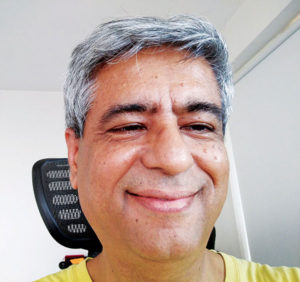Arts
Is Parsi Theater on the Verge of Extinction?

Meherzad Patel is credited with bringing back the zest and flavor of original Parsi Theater with productions such as The Buckingham Secret and The Class Act.
Parsi Theater, which once flourished in India and inspired regional theater and Indian cinema, is struggling to survive.
In September, a period play centered on the theme of persecution of Jews by the Romans, played to packed audiences in Bhopal, the capital of Madhya Pradesh. The play titled Yahudi ki Ladki, was performed as a class presentation by students of the Madhya Pradesh School of Drama. Elsewhere in Karachi, Pakistan, earlier this year, a rendition of the same musical epic was staged at the National Academy of Performing Arts. The adaptation ran for repeat showings on popular demand.
Yahudi Ki Ladki, written by eminent Urdu playwright Aga Hashr Kashmiri in the mid-19th century, belongs to the Parsi theater genre, which marked the golden era of drama in India. Today more than a century and a Partition later, the play continues to rivet audiences on both sides of the border.

Mahesh Dattani: “Parsi theater lives on in Bollywood. The ‘masala’ film probably owes its origin to Parsi theater. Melodrama with music and dance was perfected as a formula by the Parsi theater.” Photo: The Class Act
This despite the fact that Parsi theater is dwindling both in form and presentation across India even though theater as an art form is getting a renewed and corporatized facelift.
Parsi theater is a term used to describe a form of hugely influential theater staged in India between 1850 until pre-independence by the Parsi community. The stories told on stage were often drawn from Parsi culture and folklores. The medium was so popular that it is said to have even inspired the beginning of talkies in Hindi cinema in the late 1930s.
Prominent Indian director and playwright Mahesh Dattani remembers the impressive run of Parsi theater until the mid-eighties.
He recalls: “During the mid-eighties I would visit Bombay with my father on the pretext of assisting him in his business. The evenings were my own, so I would catch plays. The most popular name in commercial English theater at that time was Adi Marzbaan. My very first Parsi play was The Farrukh of Finchley with Ronnie Screwvala in it. Ronnie, Burjor and Ruby Patel, Sam Kerawala, Hosi Vasunia, were the names that appeared regularly in the theater advertisements.”
THE HISTORY
Parsi theater, which first emerged in Bombay, was later also shown across India first in English and then expanded into many languages, including Gujarati, Hindi and Urdu. It was instrumental in bringing Shakespearean adaptations for the first time in India.
The Parsis, an eminent business community in the 18th century, took great pride in creative expressions of their communal bonds and practices and this was often staged through performances.
According to historical records, the first Parsi play to be staged in India was Roostam and Sohrab in 1853 by the Parsi Natak Mandali. As its popularity grew, the theatrical presentation became grand, incorporating song, music, humor, stagecraft and all the finer sensibilities of stage shows.
The success of Parsi theater led to the development of regional theater in India, notably Marathi, Gujarati and Hindi theater. The art form also paved the way for cinema and, according to playwrights, the influence of early Parsi theater is still evident in contemporary Bollywood movies. Parsi theater suffered a setback after independence, but soon saw a revival in the 1950s. For more than a century Parsi theater ruled the roost, with proscenium style stages as well as setting up of nanny services outside the playhouses for families to enjoy the event uninterrupted.
[wonderplugin_gallery id=”12″]
THE DECLINE
However as other popular modes of entertainment gained momentum, Parsi theater began losing its steam. Dattani rues the gradual decline of Parsi theater: “The development of Gujarati and Marathi theater in Mumbai perhaps saw the decline of the Parsi theater. The Parsis as a community are dwindling and so did the audience for Parsi theater.”
But it is still influential, Dattani says: “Parsi theater lives on in Bollywood. The masala film probably owes its origin to Parsi theater. Melodrama with music and dance was perfected as a formula by the Parsi theater.”
However, with most Parsi performers now aging and few young performers stepping up, the days of Parsi theater are numbered. Last year, at a literary festival organized by Gujarat University, Yazdi Karanjia, a veteran Parsi theater artist, said: “Today the youth aspire for Broadway, which is not wrong, but Parsi theater represents a slice of Parsi life and has remained an integral part of Parsi life across the globe.” The veteran now runs the Yazdi Karanjia Group, which performs original Parsi theatrical performances across the globe.
The declining Parsi population is contributing to the genre’s woes. In 2013, the Indian government initiated the Jiyo Parsi Scheme, an ambitious plan to halt the sharp decline in the Parsi population. The $2 million scheme assisted Parsi couples with fertility treatments and education. Currently, there are just 60,000 Parsis in India and the rate of death each year far exceeds the birth rate.
While some young Parsis are trying to revive the theater scene, the population numbers are one of the biggest constraints. Meherzad Patel, one of the younger theater directors, is credited with bringing back the zest and flavor of original Parsi Theater with such productions as The Buckingham Secret and The Class Act. On the low visibility of this famed theater form, Patel says: “Stories get staged on what you see in real life. If the people in the country or the world don’t exist, how can you write a story on them? The population of Parsis is decreasing and there is very little to write on them.”
Dattani says some notable efforts are being made: “Meher Marfatia, a photographer, has done an incredible service by bringing out a coffee table book of photographs of Parsi plays. The book titled Laughter in the House is an important document. Recently, it inspired the Parsi theater community to come together and do a review of their comedies bringing back senior actors who had, not so long ago, won the hearts of thousands of theater fans.”
He also credits Patel’s work for reviving Parsi theater: “When I saw his play A Class Act a few years ago it reminded me immediately of the style, humor and content of the Parsi theatrer of the 20th century. Recently his plays, such as The Buckhingham Secret, are refreshingly original and yet rooted in the Parsi style.”
Patel said he was inspired to bring back the essence of the original Parsi theater because the quality of the form was declining: “I saw a Parsi play which was really taking the community to the dogs. It inspired me to jump into this line of work and do my part.”
Dattani adds: “The Parsis as a race are dwindling. Considering their small numbers, their contribution to the growth of modern India both commercially and artistically is hugely impressive. Hence it is important to document this art form.”



